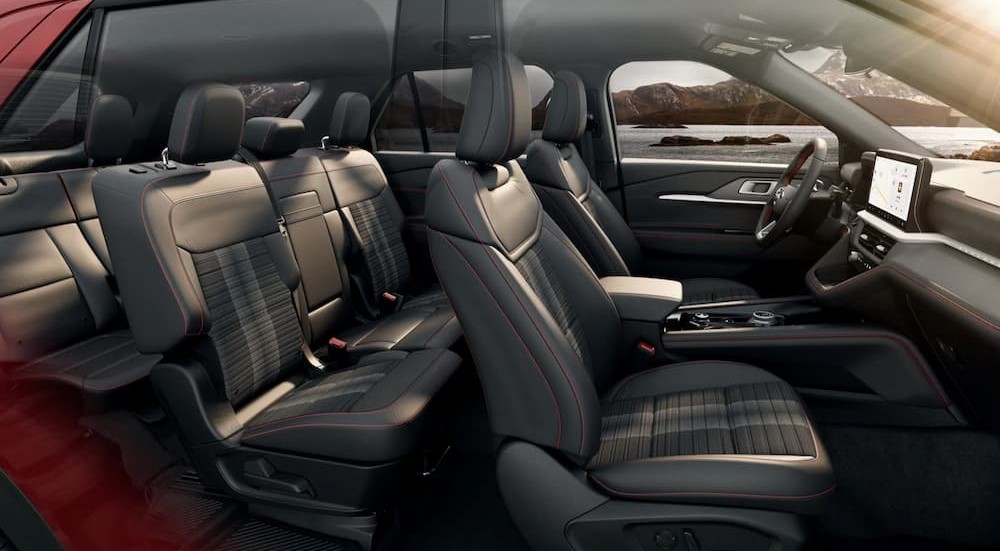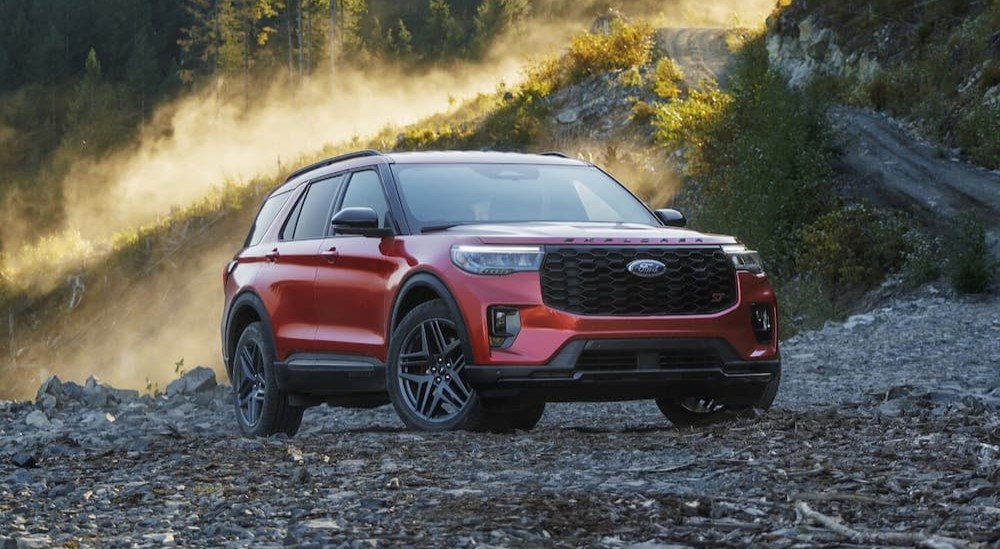Three-row SUVs are a popular choice for busy families, and it’s easy to see why. Models like the Ford Explorer offer plenty of cargo and passenger space, not to mention all those comfort, convenience, and safety features that have become an increasingly important consideration for many of today’s drivers. Add in the SUV’s lofty ride height, a 5,000 lb towing capacity, and a full suite of cutting-edge infotainment tech, and you’ve got a three-row SUV that does the segment proud. But what about speed?
Drivers typically have to make all sorts of trade-offs when selecting a family vehicle, and performance tends to be one of them, but there’s good news for drivers who are seeking a reliable family vehicle that can still provide a few thrills. Since its debut in 2020, the Ford Explorer ST has been defying the established three-row formula to provide drivers with a sport-tuned trim that turns America’s best-selling SUV into a 400 hp beast. With the ability to speed from zero to 60 mph in just 5.2 seconds, there are few SUVs that can match the Explorer ST from a pure performance perspective, especially amongst large, three-row models. So why should you consider the ST trim when shopping for a Ford Explorer for sale, and can the nearly 5,000 lb SUV possibly provide the sort of excitement the ST label promises? We’ll answer all that and more as we take Ford’s sportiest SUV for a spin.
ST-arting Off
In order to truly appreciate the Explorer ST, we need to first take a look at Ford’s history of performance-minded models. The first ST––short for “Sport Technologies”––hit the international market in 1998 with the introduction of the Ford Mondeo ST24. The midsize Mondeo was Ford’s attempt to get it on the “world car” trend of the 1990s, which saw automakers ditch the typical approach of regionalizing a model and instead produce vehicles that were virtually identical no matter what market they were sold in. The Mondeo took the world car ethos more seriously than most, with the sedan’s very name––inspired by the Latin “mundus” or “world”––reflecting the globalized approach.
But the Mondeo didn’t exactly kick off the new ST era with a bang. While it did provide slightly more power than the base model, the ST24 was still powered by the same 2.5-liter V6. Ford did give the sedan a flashy makeover with 16-inch alloy wheels, a Rally Sport body kit, and leather seats, and later graced it with a stiffer chassis and Recaro bucket seats, but it wasn’t that much of a departure from a performance perspective. This appearance-oriented approach lives on in Ford’s current ST-Line models, which feature many of the same styling upgrades––but not performance components––as their ST counterparts. The ST version of the Mondeo also never made it to the United States, though a garden-variety version of the Mondeo was sold in North America as the Ford Contour and, later, Ford Fusion.
The ST experiment really hit its stride in the early 2000s when Ford gave the ST treatment to its new Focus compact. European drivers were treated to sporty ST and RS versions of the popular new model, but it would take until 2012 for the Focus ST to make its way across the pond to us. It would be well worth the wait, treating drivers to a 250 hp compact that was a tuner dream with its turbocharged 2.0-liter EcoBoost engine and six-speed manual transmission. The Focus ST would be followed by the subcompact Fiesta ST in 2014. The smaller model’s 197 hp, 1.6-liter engine might not sound like much of an upgrade, but when you factor in the model’s 2,500 lb curb weight, it gave the car a power-to-weight ratio that allowed for plenty of rubber-burning fun.
Giving a spritely compact or subcompact a sporty makeover is one thing, but pulling off the same trick with an SUV is another story altogether. Ford was certainly up for the challenge, crafting an ST version of the Edge midsize crossover for 2019. Packed with a 335 hp twin-turbocharged V6 and a host of track-ready styling changes, the Edge ST provided a solid road map for the Explorer ST to follow. The Edge proved that there was an appetite for souped-up versions of established family favorites, serving as a solid proof of concept that would inspire Ford engineers to bring the ST badge to the brand’s best-selling SUV.
Exploring the ST
The Explorer ST turned plenty of heads with its 2020 debut and with good reason. With the ST, Ford managed to pull off a trick that few others in the industry had even attempted: infusing a spacious three-row SUV with the sort of performance that has you assessing every empty stretch of road for its redline potential. While there are a few luxury models from the likes of BMW, Mercedes-Benz, and Audi that have managed to strike the same balance of practicality and performance, the Explorer ST is a real standout when compared to the industry’s other mainstream brands.
The numbers speak for themself when it comes to the Explorer ST. Horsepower is the most gripping metric, with the ST’s 3.0-liter EcoBoost V6 churning out 400 ponies. The SUV’s potent acceleration can be credited in part to the Explorer’s 415 lb-ft of torque, which allows the three-row model to hit 60 mph in 5.2 seconds and run the quarter mile in just 14.3. The Explorer has a governor-limited top speed of 143 mph, but we’re willing to bet that the ST could easily surpass the 150 mph mark if not for the interference of the automotive nanny state. Some might be surprised to learn that the Explorer is actually the quickest ST model to date. The SUV’s zero-to-60-mph time of 5.2 seconds bests the Fiesta ST, Focus ST, and Edge ST by as much as 1.7 seconds.
Aside from gracing it with a few styling updates, Ford hasn’t really strayed too far from the original recipe with the 2025 Explorer ST. The newest model retains the same 3.0-liter V6 as the 2020 model, but that’s still a marked upgrade over the base model’s turbocharged 2.3-liter four-cylinder engine that’s rated at 300 hp and 310 lb-ft of torque. The Explorer ST is offered with standard rear-wheel drive, but those looking to put a little pep in the SUV’s step should consider the available all-wheel drive version. No matter which drivetrain you choose, you’ll be treated to a 10-speed automatic that packs a fun party trick in the form of the SelectShift manual shifting mode.
Offering paddle shifters that give the Explorer ST the precise control of a manual while leveraging the efficiency and ease of an automatic, the SUV’s transmission might represent one of its most alluring improvements, though the tuned suspension also earns its due. But the Explorer ST’s upgrades extend far beyond what’s under the hood. Ford has made sure to keep all that power in check with a set of performance brakes with red-painted front and rear brake calipers that immediately distinguish it from the base model. Inside the cabin, the ST-branded seats are treated to red accent stitching and micro-perforated Miko synthetic suede.
A Class of Its Own
When you start comparing the Explorer ST to its competitors in the three-row segment, it’s easy to see why the trim has made such an impact. Few three-row models even manage to hit the 300 hp mark, with the average being closer to 275 hp. This includes some of the Explorer’s most popular rivals, like the Toyota Highlander (265 hp), Subaru Ascent (260 hp), and Honda Pilot (285 hp). The Mazda CX-90 puts up a good fight with 340 hp, but that’s limited to the higher trims and still only gives the model a zero to 60 mph time of 6.3 seconds. The Jeep Grand Cherokee L gives the Explorer ST the closest run for its money with 357 hp, but even that falls far short of what Ford offers.
If there were any doubts about the performance bona fides of the Explorer ST, Ford’s ST SUV Experience is here to put them to rest. While performance driving courses are typically reserved for well-heeled drivers and their pricey Italian and German imports, Ford lets every Explorer ST driver in on the fun with this unique program. With locations in Asheville, NC, and Park City, UT, the ST SUV Experience pairs Explorer ST drivers with expert instructors from the Ford Performance Racing School. From evasive braking maneuvers and a Sport mode overview to a demonstration of the SUV’s pre-collision assist feature and an autocross competition, the ST SUV Experience teaches every driver how to get the most out of the Explorer’s most athletic trim. Attendees are also treated to a stay at world-class properties like the Biltmore Estate, as well as one-of-a-kind gifts, including ST SUV Experience badges that serve as a sort of diploma and can be affixed to the Explorer.
Can a Three-Row SUV Be Fast? The Explorer ST Says, Yes!
The 2025 Explorer ST answers a question few drivers had even thought to ask: can a three-row SUV be infused with the same performance credentials that have made models like the Focus ST and Fiesta ST such a hit amongst drivers? With 400 hp and a zero to 60 mph time that would give a few of BMW and Mercedes-Benz’s sedans some stiff competition, the Explorer ST certainly makes a strong case for itself. While many of today’s three-row SUVs tend to focus on the sort of pulling power that makes for good towing capacity, the Explorer ST is designed with pure speed in mind. There might be more luxurious three-row models on the market, but when you consider the Explorer ST’s relatively low starting price and best-in-class power, it’s hard to make an argument against the 2025 Explorer ST from a performance perspective.






